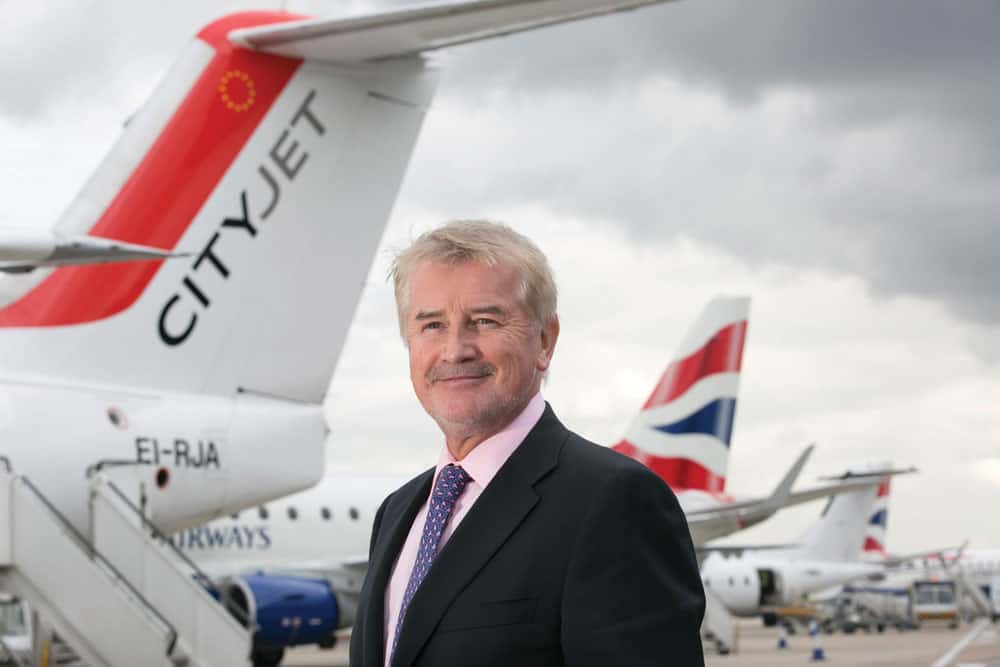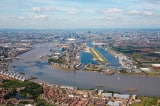Declan Collier tells Anne Whelton why vision and forward thinking are key in the fast paced airport environment.
When London City Airport was named ‘Airport of the Year’ at the 2014 Air Transport News Awards, it was a further endorsement of the investment and leadership of the city’s foremost airport.
For the 10+ million passengers that have already passed through the airport, it confirmed what they already knew − London City Airport is one of the most punctual airports and, for business travellers, it is the envy of many airports worldwide, as it is situated in the heart of one of the busiest cities for business travel in Europe.
London City Airport has invested heavily in new technology to both measure and maintain that proposition. It has also invested in its employees to deliver a better journey and experience for its passengers.
Declan Collier, CEO of London City Airport, is one such valuable investment. He joined the airport in March 2012 and since then he has been energetic in his commitment to drive growth.
Drawing on his seven-year tenure as chief executive of the Dublin Airport Authority (DAA) – during which time he saw the successful on-time and on-budget delivery of its €1.2bn Transformation Programme, which included the construction of Dublin Airport’s Terminal 2 (T2) – Collier’s vision and experience will come in handy against stiff competition to deliver required capacity for the busy London airport system.
Speaking about his instrumental role in Dublin Airport’s T2 construction, Collier says: “T2 and its related infrastructure will provide for the airports’ capacity needs for at least the next 20 years. You don’t build airport infrastructure to meet today’s demand – you build it for the anticipated demands of the future.”
With an eye on the future, Collier is not put off by the global economic challenges that have prevailed in all sectors in the last number of years. He knows firsthand that an immediate and effective response to difficult trading conditions is the best course of action.
“The aviation sector is one of those sectors of the economy that acts very much like a canary in a mine,” he says.
“It is one of the first parts of the economy to feel the impact and as the economy and people’s spending power suffered due to the severity of the economic and financial contraction, so too did the aviation sector.” During the recession, airlines reduced capacity and passenger numbers fell. With the beginning of the economic recovery passenger numbers have started to recover in Ireland and throughout Europe. According to Collier the DAA was no different and was impacted by the fall in passenger numbers. “But it had the structural and commercial flexibility and the right infrastructure to allow it to respond successfully,” he says.
Reputation
And now, two years into his role as CEO of London City Airport, Collier finds the airport to be punching well above its weight in terms of reputation, passenger numbers, economic impact, commercial resilience and ability to influence London’s development.
Compared to Dublin Airport, London City Airport is a vastly different beast to manage and run. “Operationally, it’s very different, given its location and the length of its runway; it can only be used by certain types of aircraft,” Collier explains. “In addition, because the airport is just east of Canary Wharf, in an area that is rapidly being developed, and given that we are surrounded by London’s Royal Docks, space is at a premium and at peak times, and this presents its challenges. Yet we still deliver on a ‘speed of transit’ promise and we’re the most punctual airport in the UK.”
There is no denying London City Airport’s location, convenience of access and customer experience. “Our focus is on the passenger journey and delivering end-to-end excellence, without which we wouldn’t be growing passenger numbers year-on-year, and the airlines wouldn’t be committing to the airport and increasing capacity,” Collier says.
You don’t build airport infrastructure to meet today’s demand – you build it for the anticipated demands of the future.”
Opportunities
Despite the competition, Collier is optimistic that by operating within the world’s busiest airports system, huge market opportunities present themselves, and he believes London City Airport is best placed to meet those needs and ambitions.
According to the Civil Aviation Authority (CAA), London City Airport is currently the most punctual airport in the UK, with 89% of flights arriving on time in the last quarter – an accolade that is hard to beat.
“For our mostly business audience, time is money and delays infuriate them − whether it’s a queue for security or boarding or a delay in departure. We are constantly working to improve on punctuality,” Collier reiterates.
He goes on to highlight the Smart Airport Experience, which utilises machine to machine (M2M) communications to measure, monitor and manage passenger journeys through the airport, anticipating problems before they happen and providing the customer with data and a number of options to facilitate a smooth journey, as a key investment for the airport.
“There are three things that the team is focused on constantly − passenger numbers, new routes and increased frequencies on existing routes. Our shareholders set us targets to meet and it’s up to us to deliver,” says Collier. And it seems Collier and his team are delivering on their promise, as 2013 was the airport’s best year ever with circa 3.4 million passengers passing through the terminal. “In 2014, we intend to welcome a whole lot more,” Collier enthuses. “We work with our airline customers to help them identify and develop new routes, and we market the airport directly to passengers with the aim of increasing numbers so that the airlines can justify increased frequencies.
“Of course, routes close as well as open, so we are continuously looking for new opportunities, including those presented by airlines who might not be currently flying to us, but may be open to an the opportunity.”
Sentiment
Working from passenger sentiment research to build a case for particular routes, and to demonstrate to existing or potential airline partners that there is demand, London City Airport constantly aims to open new routes for passengers. The airport can also free up slots at capacity-constrained airports by accommodating their short-haul traffic.
Having submitted a planning application last year for permission to expand the airport’s current infrastructure to accommodate an extra 50,000 take offs and landings per year − and due to an increase in movements already permitted under an application granted in 2009 − the airport is on course to double its passenger numbers to six million over the next 10 years, while continuing to attract inward investment into east London and acting as a catalyst for the regeneration of the entire area. Currently handling 70,000 flight movements per annum, there will of course be a need for enhanced and expanded infrastructure if the airport is to reach its target.
Expansion
The £200m expansion planned for the airport includes new aeroplane parking stands to accommodate larger aircraft, a parallel taxi lane to optimise runway capacity in peak operating hours, and a terminal extension to ensure convenience and speed-of-transit.
“We believe that the expansion of the airport is vital − not just to satisfy growing demand for the business travel, but also for the ongoing development of the Royal Docks and the east of London.
The population of London is growing and will reach 10.5 million over the next 15 years. At the same time, the centre of London is moving ever eastward and that will eventually see 60% of the population of London living in the east of London. That population growth is generating significant development activity and the growth of our natural catchment area will generate huge growth for the airport.”
According to Collier, the airport currently employs more than 2,100 people, of which more than 60% are local, and “the proposed development has the potential to create as many as 1,500 new jobs, providing further employment in east London with approximately 500 jobs during the construction phase,” he says.
London’s Docklands is consistently the focus for FDI and the recent announcement by ABP of its intention to build a multi-billion pound business park on Royal Albert Dock is one such example, and the connectivity to business centres across Europe and the Middle East that the airport provides − and will provide in the future − is central to this continuing.
“In terms of the wider UK economy, the airport already contributes €900m every year through business and leisure tourist spend, the operation of businesses on site, productivity savings and air passenger duty, and when this project is completed, we can expect to double that amount,” Collier concludes.
Whether focusing on the short or long-term, London City Airport’s clearly defined goals include achieving revenue targets and increasing its focus on the customer. New routes, increased frequencies and growing passenger numbers will continue to drive the business’ commercial and marketing activities today and into the future.
FACT FILE: London City Airport
- London City Airport is located three miles from Canary Wharf, seven miles from the City of London and 10 miles from Westminster.
- Easily accessed via the Docklands Light Railway and London Underground.
- Unlike larger airports where passengers are required to arrive two hours before a flight, at London City you can check in, clear security and relax in the departure lounge within just 20 minutes of arriving at the airport.
- On arrival it takes just 15 minutes to disembark, pass through customs and reach the exit.
- The airport currently offers flights to more than 40 destinations across Europe and the US.





